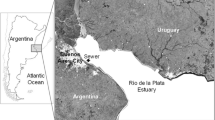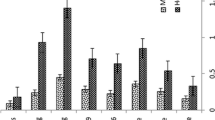Abstract
A total of 19 PCB congeners were determined in muscle of 2 European roach (Rutilus rutilus) and in muscle and liver of 3 pike (Esox lucius) of a small rural lake in the southern Black Forest (Germany) to examine the biomagnification in freshwater fish. The lake is known for a relatively high PCB contamination of its sediments due to past local emissions. The presence of a structure dependent biomagnification in these freshwater fish of two different trophical levels is confirmed. The relative contents of PCB congeners with vicinal H-atoms in m,p- and to a lesser extent, o,m-positions become smaller from roach to pike indicating a stronger induction of PCB metabolizing isoenzymes in the predatory fish. This could also be shown by application of the metabolic slope concept.
Similar content being viewed by others
Author information
Authors and Affiliations
Additional information
Received: 24 July 1997 / Revised: 22 December 1997 / Accepted: 1 January 1998
Rights and permissions
About this article
Cite this article
Looser, R., Ballschmiter, K. Biomagnification of polychlorinated biphenyls (PCBs) in freshwater fish. Fresenius J Anal Chem 360, 816–819 (1998). https://doi.org/10.1007/s002160050816
Issue Date:
DOI: https://doi.org/10.1007/s002160050816




